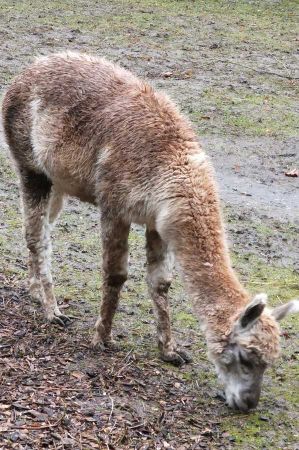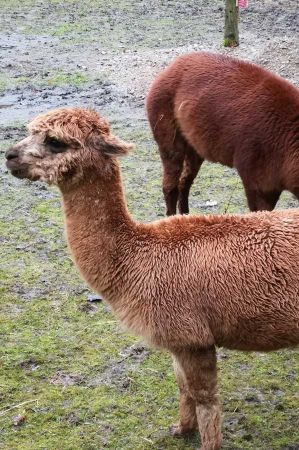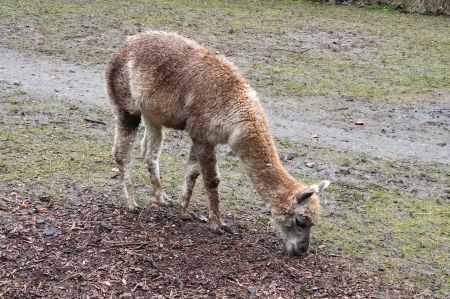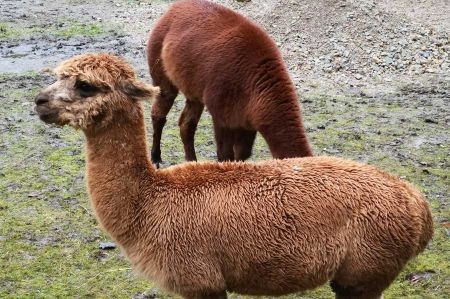Alpaca-encounter during the Christmas Eve walk
- Written by Portal Editor
Gray sky with numerous showers, not exactly tempting weather for a walk through the forest. Alternatively, spending the afternoon before Christmas Eve in front of the TV wasn't really an alternative either.
And if, thanks to Corona, there are warnings against contacts anyway, the cloudy, rainy weather is no longer so significant. Indeed, it is more a question of clothing.
Through the unfortunately very sparse forest today, we first went in the direction of Mühltal / Finnek, then on to the imposing forest swimming pool of Rastenberg. We had stopped here a few times and enjoyed the atmosphere at the outdoor pool with hearty Thuringian grilled sausage. In the Mühltal we came across the alpaca meadow there, which we had passed several times without, however, meeting the animals themselves. Today we were lucky because the alpacas could be seen outside.
Alpaca - camels from the Andes of South America
 The alpaca is a domesticated form of camel originally from the South American Andes, which is bred primarily for its wool. In the meantime, to be found more often here, because alpacas are even used in animal-assisted therapy in Europe because of their calm and peaceful character.
The alpaca is a domesticated form of camel originally from the South American Andes, which is bred primarily for its wool. In the meantime, to be found more often here, because alpacas are even used in animal-assisted therapy in Europe because of their calm and peaceful character.
The domestication of alpacas as well as llamas started 6,000 to 7,000 years ago. While the lama was primarily used as a pack animal in South American civilizations, the alpaca was bred for its wool. The Inca considered an alpaca coat to be a symbol of prosperity; However, the even finer wool of the vicuñas was reserved for the ruling caste. The Incas raised large herds of alpaca. This changed with the conquest of Peru by the Spaniards, who brought sheep and showed no interest in researching the native farm animals. The alpaca became a farm animal for the poor, Indian population and was meanwhile almost extinct.
Only with the independence of the states of South America the value of the alpaca was recognized again. Breeding was resumed and the wool was exported all over the world. Today there are around three million alpacas, mostly in southern Peru, western Bolivia and Chile.
Alpaca breeding in Europe is very popular
 In Europe, too, more and more alpacas are being kept, partly as a hobby, partly for breeding. The breeding animals were initially imported, but now the alpacas in Europe have the necessary fibre quality and there is a tendency to pay more attention to the pedigrees of the animals.
In Europe, too, more and more alpacas are being kept, partly as a hobby, partly for breeding. The breeding animals were initially imported, but now the alpacas in Europe have the necessary fibre quality and there is a tendency to pay more attention to the pedigrees of the animals.
There are basically two types of alpaca, the Huacaya and the Suri. They differ in the structure of their wool: The Huacaya alpaca has fine, evenly curled fibers and some outer hairs. The Suri-Alpaca, on the other hand, has no frizz in the fibre, the hair forms curly, straight strands that hang down on the animal. As a result, Suris often appear narrower than Huacayas.
As with all camels, the body of the alpacas is characterized by relatively elongated, slender legs, a long, thin neck and a small, triangular head. As New World camels, they have no hump. They are slightly smaller than llamas and reach average heights of 80 to 100 cm at the withers. The life expectancy of an alpaca is between 20 and 25 years. Like all camels, alpacas are social animals (herd animals) and feel most comfortable in groups. They are herbivores and feed almost exclusively on grasses. Like all camels, they have a three-part stomach that makes it easier to digest the plant food. They also do not have upper incisors, but a chewing plate.
Alpacas have also become farm animals in Europe
 The animals are usually shorn once a year. The raw wool can be processed into high-quality alpaca yarn. The fibre yield when shearing an animal is three to six kilograms per animal and per year, but only about one to three kilograms of this can be used. Alpaca wool is a soft, silky, shiny natural fiber. Compared to sheep's wool, it is warmer, finer and has a lower fat content. The entire processing of the alpaca fibre such as preparing, carding, spinning, weaving and other finishing processes are very similar to the processes of sheep wool processing.
The animals are usually shorn once a year. The raw wool can be processed into high-quality alpaca yarn. The fibre yield when shearing an animal is three to six kilograms per animal and per year, but only about one to three kilograms of this can be used. Alpaca wool is a soft, silky, shiny natural fiber. Compared to sheep's wool, it is warmer, finer and has a lower fat content. The entire processing of the alpaca fibre such as preparing, carding, spinning, weaving and other finishing processes are very similar to the processes of sheep wool processing.
In Germany, alpacas have been recognized as farm animals within the meaning of Section 51 Assessment Act since 1996 and are thus equated with sheep or horses, for example. They can therefore be held by private individuals without further authorization. The prerequisite is species-appropriate keeping in accordance with the Animal Welfare Act. With alpacas that means at least: no solitude; 1000 square meters of pasture for the first two animals, another 100 square meters for each additional animal; a weatherproof shelter with at least two square meters of space per animal. A pure stable-keeping is not appropriate to the species.
Please read as well:
Longdendale Trail - hike up to the moor heights
Biketour Legnice - with AZUB Trike and BTurtle
